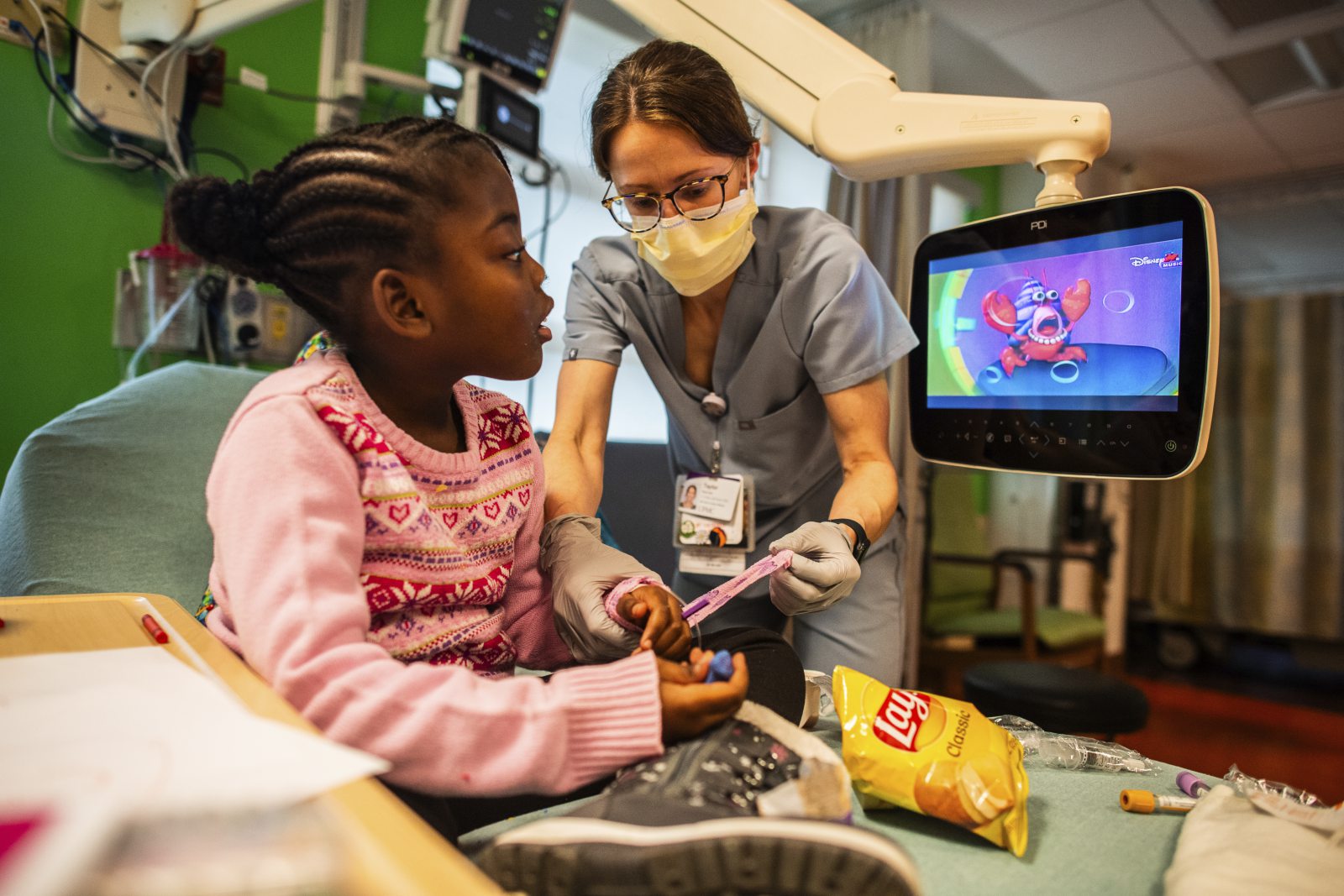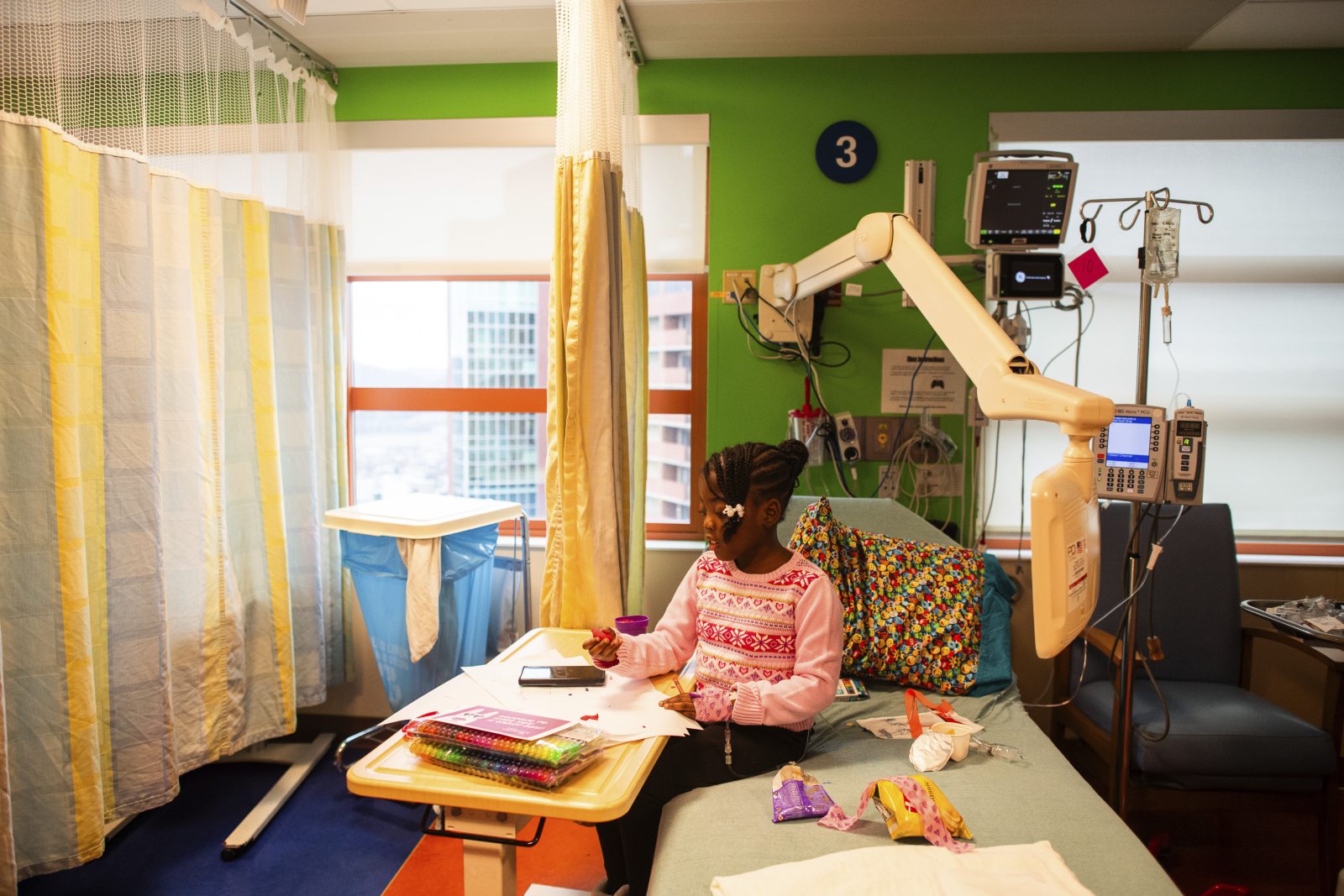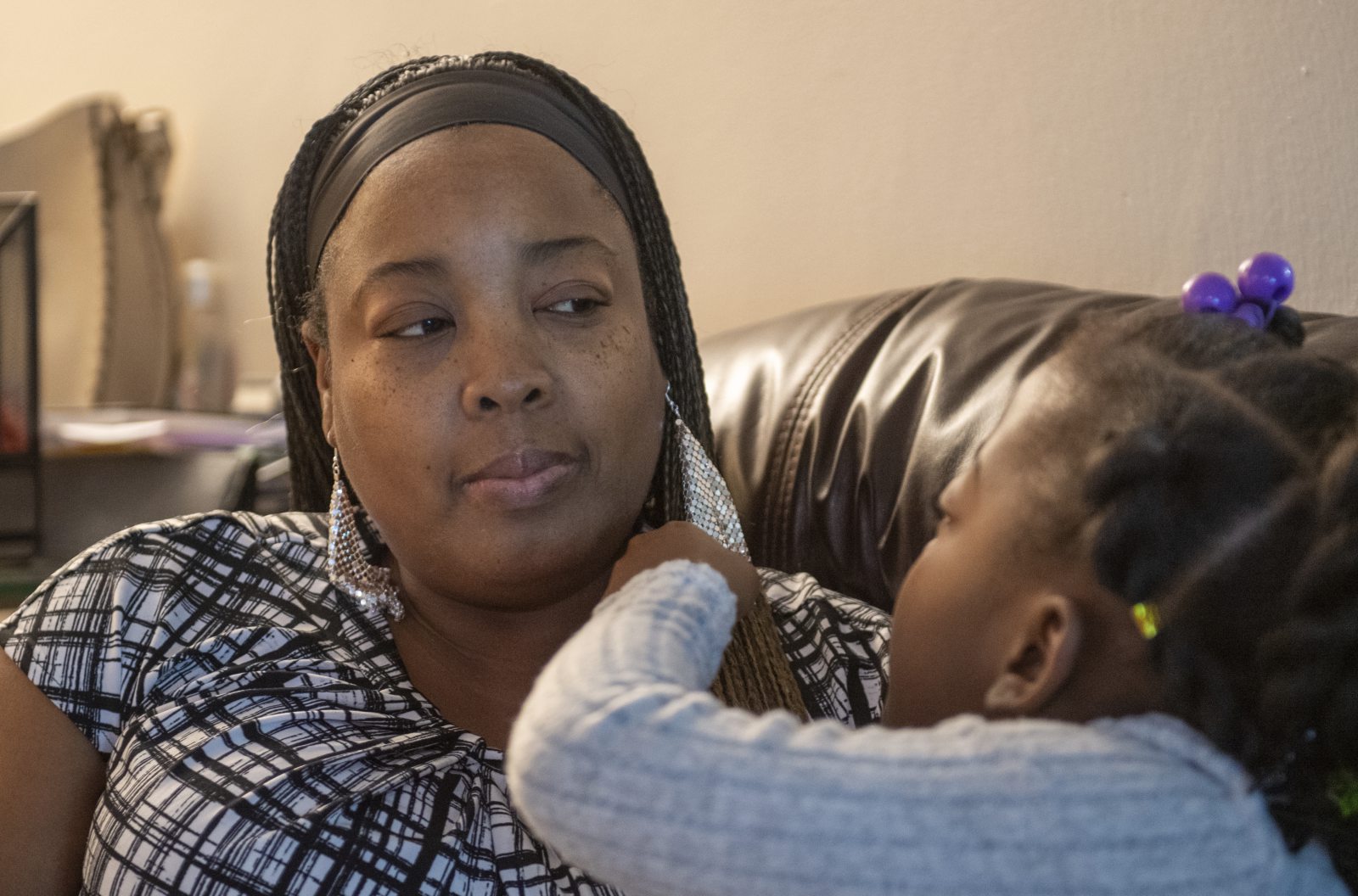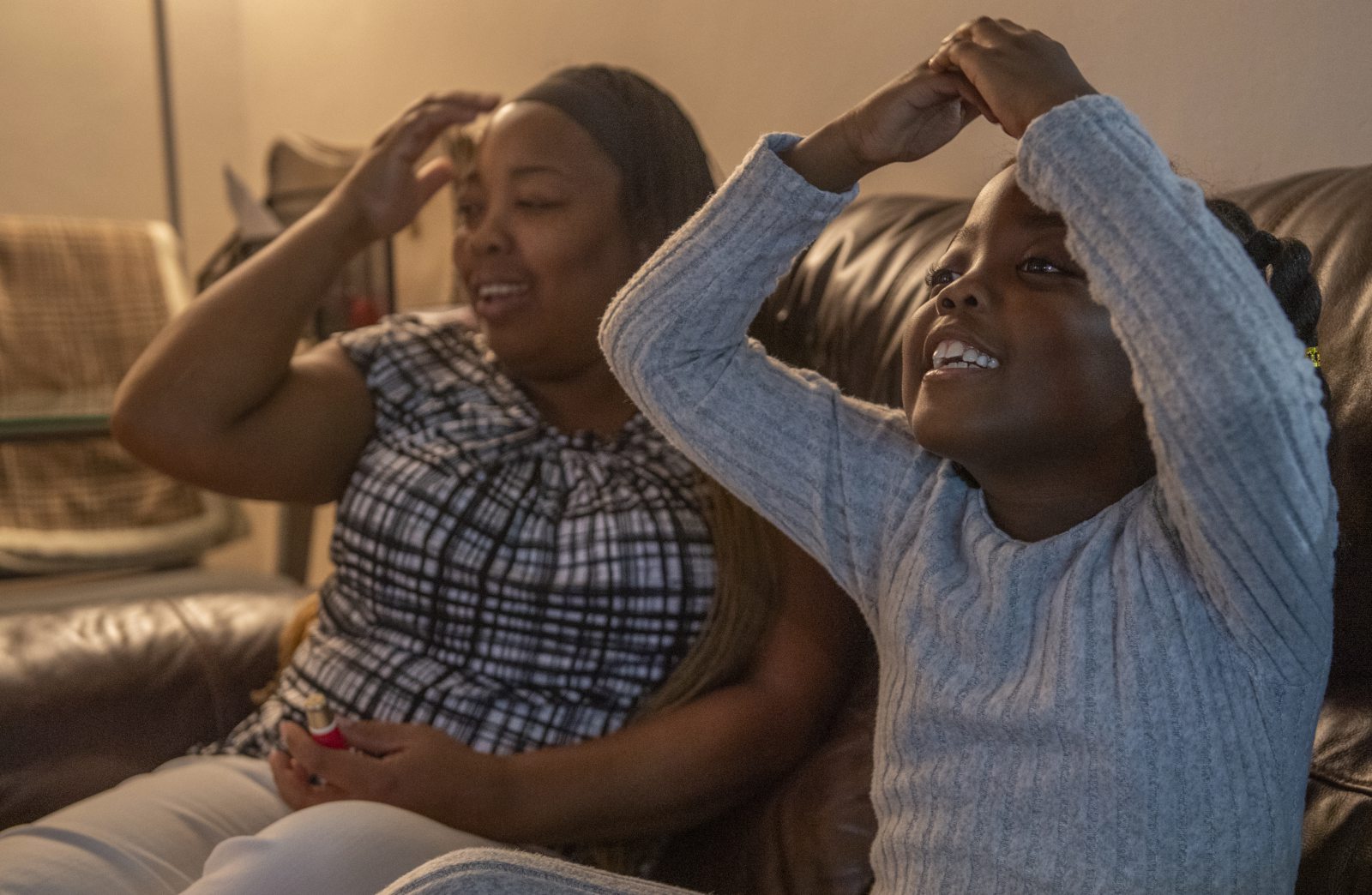

Story by SHAYLAH BROWN
TribLive
March 2, 2025
Esther Nkemakolam runs her fingers through kinetic sand and sings a “Moana” song as UPMC Children’s Hospital nurse Taylor Brennan gets to work drawing blood.
Esther is back for her monthly blood transfusion.
It’s a frigid February morning, but the routine is familiar for Esther, a bubbly 7-year-old first grader from New Kensington whose bouncing hair and ballies and whimsical behavior belie her underlying condition.
Esther is one of about only 4,000 people in Pennsylvania with sickle cell disease, an inherited blood disorder in which a genetic mutation causes abnormal C-shaped, or sickle-shaped, red blood cells. The disease can cause lung problems, acute chest syndrome, stroke and other complications. It also can be fatal.
The disease largely affects the Black community. About 9 in 10 people in the United States who have sickle cell disease are of African ancestry or identify as Black, according to the federal National Heart, Lung, and Blood Institute.
The only known cure is stem cell and bone marrow transplants. Treatments — such as blood transfusions, medication and bone marrow or stem cell transplants — help mitigate complications. But in late 2023, the U.S. Food and Drug Administration announced a breakthrough: approval of two milestone treatments, Casgevy and Lyfgenia, representing the first cell-based gene therapies for the treatment of sickle cell disease in patients 12 years and older.
“Children with sickle cell disease … have a high risk of stroke when they are just a few years of age. Nowadays we can prevent 90% of strokes by doing a test to determine if the child is at risk. If the child is at risk, we put them on transfusions — transfusions prevent strokes,” said Dr. Enrico Novelli, director of the Adult Sickle Cell Program at UPMC. “In the past because stroke was so common, some children were left with long-term neurological problems and others developed cognitive dysfunctions.”
Adults with sickle cell might have memory loss and the inability to concentrate.
For Esther, and her two sisters and parents, gene therapy could be a breakthrough.
“When that time comes, I will absolutely consider it,” said Esther’s mother, Claudeen Nkemakolam, 43, of New Kensington, referring to her daughters.

Claudeen has sickle cell disease. Her youngest daughter, Priscilla, 3, also has the disease. Claudeen’s oldest daughter, 18-year-old Deshae Perkins, has the sickle cell trait, a condition in which a person inherits a sickle cell gene and one normal hemoglobin gene (people with the trait usually do not exhibit symptoms of the disease). Ether’s father, Peter Nkemakolam, who often takes her to transfusion appointments, has the sickle cell trait.
Esther has sickle cell anemia, one of the more severe types of the disease.
“Every month I have a blood transfusion,” she said. “When I have my transfusion, first I get my breakfast and then when the needle comes, I am brave.”
During the procedure, she remembers to keep her arm still.
“When you are done, the machine beeps and the water bag comes before the blood bag,” she said. “It feels cold, like tingling through your body.”
The transfusion can take up to five hours, but is well worth it: Transfusions increase the number of healthy red blood cells and lower Esther’s risk of having a stroke.
Watching Esther play and jump around at home, her condition is not visibly obvious. She frequently plays with her younger sister and enjoys drawing and art.
“Overall, my family has been doing well living with sickle cell. Esther has been followed by a health care practitioner since birth, and as she grows, the information about her sickle cell is gradually given to her,” Claudeen said.

People with sickle cell disease have red blood cells that are shaped similar to a crescent moon rather than ones that are round and flexible. They are rigid and block blood flow.
For some children, sickle cell disease means frequent bouts of intense, unrelenting pain that can lead to vomiting, known as crises, according to Novelli.
The disease developed approximately 7,300 years ago throughout India and Africa to help protect against malaria, according to a study by the American Journal of Human Genetics. With enslavement, the gene was passed down to different generations of Black people, said Michael Matthews, executive director of the Children’s Sickle Cell Foundation, a Pittsburgh-based nonprofit that supports individuals living with sickle cell disease.
Matthews estimated that more than 500 people are affected by sickle cell disease in Allegheny County.

Sickle cell disease is diagnosed at birth with a blood test called hemoglobin electrophoresis. Early detection can be critical, Novelli said.
“If we can identify the children who are born with a disease, we can treat them before they get sick, and so we allow them to survive and lead a healthy life,” he said.
Although the disease disproportionately affects Black people, it also has been seen in Hispanic people and those of Middle Eastern descent.
The U.S. Centers for Disease Control and Prevention reports that 1 out of every 365 Black people has sickle cell disease. The sickle cell trait affects 10% of Black people, compared to .3% of white people.
Nearly 4,000 Pennsylvanians were reported to be living with sickle cell disease by the end of 2020, according to the state Sickle Cell Disease Community-Based Services and Support Program.

Casgevy and Lyfgenia, the treatments approved by the FDA in late 2023, are one-time gene therapy treatments that use an individual’s blood stem cells to produce healthy, fetal hemoglobin only made in the body during infancy, according to Novelli.
A patient must receive a high dose of chemotherapy before the treatment because it erases all of the sickled cells’ genes or mutated hemoglobin in the body, according to Yale Medicine.
Those genes are then replaced with a healthier hemoglobin that would, in theory, allow the body to copy the gene and begin producing healthy hemoglobin, leading to an increase in non-sickled red blood cells.
Patients must be 12 or older and have frequent life-threatening crises that occur when blood flow is being blocked by sickled cells to the heart, brain or lungs, which can lead to organ failure.
“During a crisis, it is severe, unpredictable pain that can affect any bone, sometimes multiple bones or muscles,” Novelli said. “When there’s lack of oxygen to a tissue, the tissue may experience infarction — which is the death of tissue — so that that’s painful if it occurs in the bones, but it is also life-threatening if it happens in the lungs. Sometimes the dysfunction can affect many organs at the same time, and that is really life-threatening.”

Geographic and economic access are barriers to receiving the new treatments. There’s also a healthy dose of skepticism in the Black community about the medical field because of historical wrongs, such as the Tuskegee Syphilis Experiment.
Casgevy and Lyfgenia treatments are not offered in Pittsburgh, but they are available at Children’s Hospital of Philadelphia, Cleveland Clinic, and Nationwide Children’s Hospital in Columbus, Ohio.
Allegheny Health Network did not have a timetable for when the treatments would be available locally. UPMC said it is exploring options but does not yet offer the gene therapy because it is so new.
These one-time treatments range between $2 million to $3 million per patient and are not covered by all insurance plans. Blue Cross Blue Shield, Aetna, Cigna and Point 23 Health offer coverage.
BioPharma Dive, a news website covering the biotech and pharmaceutical industries, reported that while “several dozen” people started the process for one of the two gene therapy options, as of December 2024, only two had gotten the infusion.

Ty Yates, program director and community health worker at The Children’s Sickle Cell Foundation, has sickle cell trait, as does her husband.
Their son, Titan, 6, has sickle cell disease. He has been taking Hydroxyurea medication since birth to reduce crises and acute chest syndrome.
They have not told Titan yet that he has sickle cell disease.
“We just tell him you are getting medication to prevent you from getting sick or having an issue where your body hurts,” Yates said.
They are raising him to have awareness of his body and prioritize his self-care by reminding him to rest. Titan also meditates, uses a heated blanket and takes baths in Epsom salt.
Matthews said his now 26-year-old son has sickle cell. Watching his son go through a crisis was difficult, he said.

Navigating the disease and raising children with it gets challenging, Claudeen Nkemakolam said.
“When I am not working, generally I just want to rest,” said Nkemakolam, who works 50 to 60 hours per week as a direct support professional with Passavant Memorial Homes Family of Services. She is also a Realtor with Coldwell Banker.
Claudeen was supposed to take her daughter and Esther’s best friend to Urban Air Adventure Park, but Claudeen became so exhausted that her oldest daughter had to step in instead.
“Sometimes that will happen — I’ll plan something to do, and I’ll be exhausted when it comes around,” she said.
The Nkemakolam children have avoided crises but are sensitive to viral and bacterial infections, which have caused frequent hospitalizations.
Tolerance levels can fluctuate from person to person.

Yates said parents of children with sickle cell should stay informed and be transparent with their hematologist.
Novelli said he is optimistic about the future of sickle cell research.
“All over the world, governments are starting to really want to act. For instance, in India, there is a very ambitious goal of completely eradicating the disease in about 20 years or so,” he said, calling the timeline “incredibly ambitious.”

Sickle cell disease is an inherited blood disorder in which a genetic mutation causes abnormal C-shaped, or sickle-shaped, red blood cells. To have the disease, a person has to have inherited a sickle cell gene from each parent.
Sickle cell trait is a condition in which a person inherits a sickle cell gene from one parent.
Sickle cell trait does not develop into sickle cell disease, but two people with the trait can pass down sickle cell disease to their child. One person with the trait and one person with normal hemoglobin would not pass down the disease, but they have a 50% chance of passing down the trait.
Someone with sickle cell disease will always pass down the disease or the trait to their children.
A hemoglobin electrophoresis blood test will also determine whether a person has the sickle cell trait.
“When we do gene therapy or we do a stem cell transplant, we correct the blood stem cells — we don’t correct the gene. So people who have had (sickle cell disease) who have been cured by a transplant can still pass on the gene,” said Dr. Enrico Novelli, director of the Adult Sickle Cell Program at UPMC.
• Sickle cell disease affects more than 100,000 people in the United States and 8 million people worldwide. In the United States, 9 of 10 people who have sickle cell disease are of African ancestry or identify as Black.
• About 1 in 13 Black babies are born with sickle cell trait, meaning that they inherited a sickle cell gene from one parent.
• About 1 in every 365 Black babies are born with sickle cell disease, meaning they inherited a sickle cell gene from each parent.
Source: https://www.nhlbi.nih.gov/health/sickle-cell-disease
Shaylah Brown is a TribLive reporter covering art, culture and communities of color. A New Jersey native, she joined the Trib in 2023. When she’s not working, Shaylah dives into the worlds of art, wellness and the latest romance novels. She can be reached at sbrown@triblive.com.